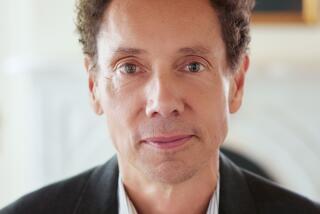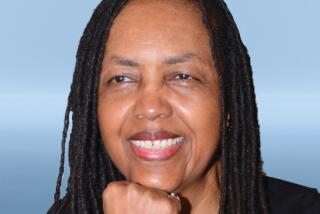Malcolm Gladwell’s ‘David and Goliath’ champions the underdog
What if we lived in a world where the weak were really strong, and all of our disadvantages could easily become advantages?
In his new book, “David and Goliath: Underdogs, Misfits, and the Art of Battling Giants,” bestselling writer Malcolm Gladwell tells us we’re already living in that kind of world. Even something as debilitating as dyslexia can be an ambitious man’s ticket to success.
“The one trait in a lot of dyslexic people I know is that by the time we got out of college, our ability to deal with failure was very highly developed,” says Gary Cohn, a man of humble origins whose bold decisions take him to the top of the U.S. financial industry. “I wouldn’t be where I am today without my dyslexia.”
Books: Sign up for our email newsletter
Gladwell, a staff writer at the New Yorker, has sold a ton of books explaining seemingly counterintuitive and complex arguments about psychology and the social sciences to a mass audience. In “David and Goliath” his mission is to show us how our thinking about power, influence and success is often misguided and wrong.
“We have, I think, a very rigid and limited definition of what an advantage is,” Gladwell writes. “When we see the giant, why do we automatically assume the battle is his for the winning?”
As always, Gladwell populates his pages with insights illustrated by one memorable character study and anecdote after another. He can be an efficient and persuasive storyteller, and in this book his cast of “Davids” include French Impressionist painters, undersized basketball players and civil-rights marchers; his “Goliaths” include the French art establishment, basketball traditionalists and segregationist police chiefs.
But “David and Goliath” isn’t just about underdogs defeating giants. It’s also, under Gladwell’s stretching of the “Goliath” metaphor, about the strategies underdogs use to overcome societal obstacles and tackle personal challenges. As Gladwell widens his arguments, venturing into topics as diverse as teacher-student ratios and the Holocaust, “David and Goliath” becomes an uneven book, alternately compelling and essential and then scattershot and unconvincing.
His chapter on the damage caused to many bright students by the most exclusive universities should be required reading for every parent worrying about which college a son or daughter should attend. Gladwell argues persuasively that the most prestigious colleges end up frustrating the ambitions of many bright students who would be better off at midlevel universities. But that chapter is preceded by a lengthy discussion on class size in the public schools of the Connecticut community of Shepaug Valley that reads like a superficial treatment of a much larger policy discussion — and that time and again condescends to the reader.
“Can you see why Teresa DeBrito was so worried about Shepaug Valley?” Gladwell asks, after plying us with tables and statistics and recounting DeBrito’s work as a principal struggling with declining enrollment. At other points in the book he asks, “Did you follow that?” and “Can you see why this is so fascinating?”
It’s frustrating, not fascinating, to see a writer such as Gladwell adopt the didactic tone of the narrator of a television science program. And yet much of “David and Goliath” truly is intriguing and inspiring, especially when Gladwell discusses “desirable difficulties.” A high percentage of prison inmates are dyslexics, he tells us, and so are a high percentage of entrepreneurial millionaires — both facts are reflections of the personal challenges dyslexics face and the way they respond to them. In a similar vein, Gladwell’s account of the journey of Dr. Emil “Jay” Freireich is unforgettable.
Freireich, the son of Hungarian immigrants, is raised during the Great Depression in Chicago and suffers through a childhood of great poverty and neglect. It makes him a hard and angry man and also gives him an unbreakable will. Those qualities serve him well when he becomes a doctor and leads a series of clinical trials of new drug treatments for child victims of leukemia. The trials force Freireich to confront suffering and dying children every day and to push himself and his patients to the limits of human endurance.
“How Jay did it, I don’t know,” one doctor tells Gladwell.
“But we do know, don’t we?” Gladwell writes. “He had been through worse.” The resulting “drug cocktail” regimen is now a standard cancer treatment and has saved thousands of lives.
But in the next chapter, on the civil rights movement, Gladwell is once again on shaky rhetorical footing as he discusses Martin Luther King Jr.’s 1963 battle against segregation in Birmingham, Ala. Gladwell’s contribution to this oft-told American story is to compare the movement’s tactics (which helped lead to the passage of the Civil Rights Act) to the “trickster” tales of many a folk legend.
“De rabbit is de slickest o’ de animals de lawd ever made,” he writes, quoting the tale of Brer Rabbit popular among slaves.
Like tricksters, the movement’s leaders fooled the Birmingham police into thinking its ranks were bigger than they really were and refused to play “by the rules” because black people had “nothing to lose,” Gladwell writes. As he makes such obvious and not especially profound arguments, Gladwell can’t help but gloss over the complex and bloody history of African American resistance, courage and suffering.
In the end, “David and Goliath” feels like the work of two very different writers. One is an intelligent thinker who feels the need to illuminate hidden human truths. And the other is a showman, a master of ceremonies shuffling one performer after the other onto a stage, afraid that if he lingers too long on one act, he’ll lose his big audience forever.
David and Goliath
Underdogs, Misfits, and the Art of Battling Giants
Malcolm Gladwell
Little, Brown and Company: 320 pp., $29
More to Read
Sign up for our Book Club newsletter
Get the latest news, events and more from the Los Angeles Times Book Club, and help us get L.A. reading and talking.
You may occasionally receive promotional content from the Los Angeles Times.







